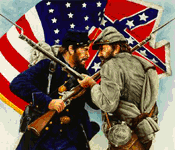 |
Civil War Battles |
|
State War Records |
| AL - AK - AZ - AR - CA - CO - CT - DE - FL - GA - HI - ID - IL - IN - IA - KS - KY - LA - MA - MD - ME - MI - MN - MS - MO - MT - NE - NV - NH - NJ - NM - NY - NC - ND - OH - OK - OR - PA - RI - SC - SD - TN - TX - UT - VT - VA - WA - WV - WI - WY |
The Battle of Corpus Christi
August 16-18, 1862 in Corpus Christi, Texas
 |
|||||||||||||||||||||
|
In mid-July, Capt. John W. Kittredge, on blockade duty off the coast of Texas, planned to attack Corpus Christi. Though his 100-man forcr could not hold the town, he hoped a victory would strenghten the Unionist mayor's position. Word of Kittredge's plans reached the town, where pro-Confederates immediately prepared to defend themselves. In the absense of an experienced military leader, Provost Marshal Col. Charles G. Lovenskiold assumed command of the few resident volunteer companies, sent cotton and tobaccoo stores inland to prevent their capture, and sank 3 cement-laden schooners in the channel to block the entrance to Corpus Christi Bay. When Maj. Alfred Hobby arrived with 300 men from the 8th Texas Infantry on the July 20th, Lovenskiold willingly turned over command.
Hobby would be commanding his first battle with untrained volunteers. At his disposal were 3 smoothbore cannon, 1 18-lb. and 2 old 12-lb., the latter abandoned by the U.S. Army several years earlier. The Seacoast Defense Battery also had 2 6-lb. artillery pieces, which the gun crews had not learned to use properly for lack of gunpowder with which to practice. Without any experienced artillerists to handle the ordnance, Hobby willingly accepted help from Mexican War veteran Felix Blucher and from Billy Mann, a disabled Confederate soldier recently returned from the fighting at Island No. 10.
On August 12th, Kittredge cleared the bay by using the steam power of the recently arrived Sachlem. Early the next day and again in the afternoon, he landed at Corpus Christi under a truce flag. His parley with Hobby resulted in a 48-hour truce during which civilians were to be evacuated from the cuty. After he departed, Hobby unwisely ordered the cannon placed in the abandoned Kinney Fort on a bluff overlooking the bay. Mann advised the commander to move the cannon from the bluff to existing fortifications along the water at the city's northern end, but it was too late to reposition the ordnance before the truce expired. When Kittredge failed to attack once the truce ended on the 16th, Hobby feverishly hauled the ordnance to the beach. The work was finished about 2:00 A.M., and the troops hid behind the earthworks and in nearby ravines.
At daybreak on the 17th, either Mann or Blucher shouted the order to fire, taking Kittredge's men by surprise. Shells hit the Sachem and the Carypheus, both of which returned the fire ineffectively. Of the 5 small vessels in Kittredge's fleet, 2, the Reindeer and the Bella Italia, sat becalmed too far out of artillery range, and the Breaker stood in reserve as a hospital ship. The returning shelling inflicted only superficial damage on several buildings.
On the Confederate side, Mann directed the men from atop the earthworks, encouraging and warning them of incoming shells. The battle continued for 4 hors before Kittredge withdrew his ships. He reopened the fighting briefly, but ended the battle for the day after expending 300 shells against the Texans. Certain Kittredge would attack again, the defenders , reinforced with volunteers from nearby communities, prepared for another assault.
On the morning of the 18th, Kittredge sailed to a position about a mile south of Hobby's battery to launch a land/sea attack. The Bella Italia landed 30 men and a 12-lb. howitzer. The troopers rushed toward the battery, firing rapidly, while the ships, 400 yards offshore, bombarded the Confederates with grape and shrapnel. Unable to turn his cannon, Hobby ordered a company of cavalry to stand in reserve, and with 25 volunteers, advanced on the Federals, by now only 600 yards from his works. Outfought, Kittredge's men retreated under cover of heavy fire from the ships. The cavalry joined the route before Hobby ended the counterattack. Kittredge shelled those buildings he thought hid Confederates, then withdrew to nearby Shell Bank to make repairs.
Two days later, Brig. Gen. Hamilton P. Bee arrived in Corpus Christi to reinforce the city's defenses. Though the defenders were highly praised and Corpus Christi was proclaimed the "Vicksburg of Texas" by a local newspaper, from then until the end of the war the town languished. In 7 months before Kittredge was captured by Confederates in September, he effectively ended the coastal trade in the area, and a garrison stationed on Mustang Island in 1863 harassed the townspeople frequently. Union troops under Maj. Gen. Nathaniel P. Banks occupied Corpus Christi on November 16th, 1863.
Although the battle of Corpus Christi was acclaimed throughout the state as the "Vicksburg of Texas," the victory brought no permanent security to the city's citizens. The defending soldiers were soon withdrawn, leaving the city vulnerable to forays by a United States military force that occupied nearby Mustang Island during 1863-64. Many citizens, faced with starvation, offered allegiance to these forces in exchange for food and protection, and Corpus Christi remained a divided and stricken city for the duration of the war.
